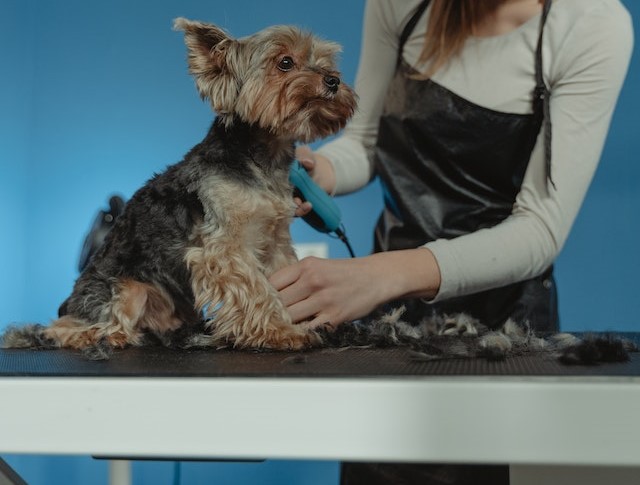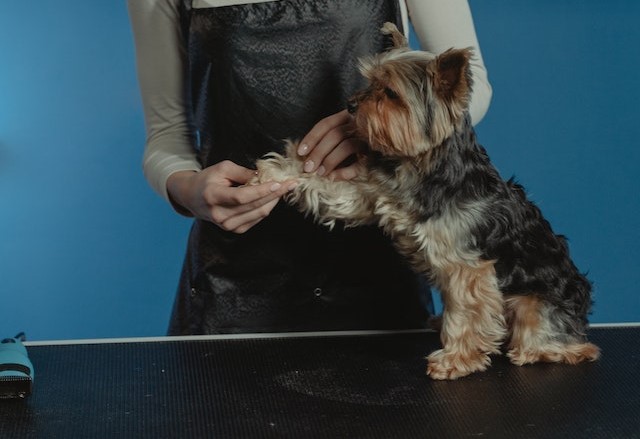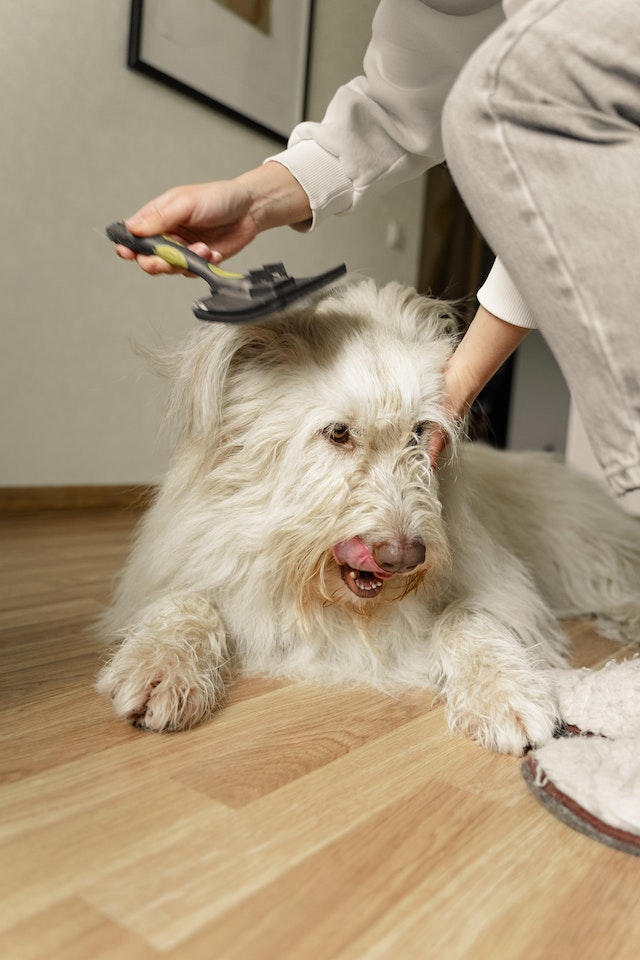How To Take Care
Of
Your Dog's Coat
At Home
By Linda Hamilton
I may earn a small commission if you buy stuff through the links 🙂

Every dog’s coat requires caretaking.
When you are contemplating getting a dog make sure you educate yourself on coat care for dogs!
In this article, I’ll tell you all you need to know about coat care!
Why taking care of your dog's coat is important?
Brushing your dog frequently removes dead hairs while also taking care of his skin. It also reduces ticks and other parasites.
Some dogs require brushing every day. Dogs with curly, long, combination, or double coats require daily coat care. Dogs with short, or wire coats don’t need brushing or combing as often. For some breeds with a shorter coat, brushing once a week is enough.
If you don’t take care of your dog’s coat, mats, tangles and knots can occur. This might cause pain and the knots may get even worse if not taken care of. Often groin area, behind ears, chest, and legs are areas where knots develop easily. So when brushing your dog, put extra attention to these places.
When you brush your dog and take care of his coat you are also able to look out for lumps, scars and other injuries that require a vet visit.
Make sure when you brush your dog it is a positive experience for him. That way he can relax and your bond can become stronger.
Some breeds require professional grooming, but is also good to be able to do it at home too.
You can take care of your dog’s coat on the floor or then on a grooming table. A grooming table can be better for your posture since you don’t have to crouch.
Different types of coats and how to take care of them
Short coat and smooth
- Short coat lays close to the skin
- Easy to maintain
- Dogs with a short coat tend to have sensitive skin
- High shedding
The maintance of a short coat is the easiest of them all. Short and smooth coats require coat care once a week. However, with a few minutes of daily fur care, you can make the weekly treatment easier, and it won’t require as much effort.
With daily brushing, you can get loose hairs out of the coat. This also ensures the health of the coat and the skin since it spreads out skin oils throughout the coat. I recommend using a soft bristle brush for this.
Weekly coat treatment should be done precisely. Start the treatment with a blow dryer and set it on the lowest heat. This helps to get rid of loose hair. Make sure you go through every part.
Then take a carding groomer and pick up all the loose hairs that didn’t come off earlier. Stop grooming when all loose hairs have been removed.
Some dogs with short coat are prone to allergies. So if allergies occur, talk to your veterinarian.
Best supplies for short coated dogs
Breeds with a short coat
- Dalmatian
- Short-haired Chihuahua
- Doberman Pinscher
- Bull terrier
- German Shorthaired Pointer
- Daschund
- Whippet
- Greyhound
Wire coat
- Wire coat, which is harsh and bristly, covering entire body
- Non-shedding
- Soft and thick undercoat covering majority of the body
- Undercoat can shed seasonally, mostly when it’s cooler
- Some breeds with wire coat can have more of wiry coat and some more smooth coat
Dogs with a wire coat should be brushed once a week. If the coat is not brushed out, it can form mats, knots, and tangles.
Start brushing the coat with a slicker brush. This kind of brush stimulates the skin and removes loose hairs and excess undercoat.
After you finish this you can take a comb and remove any tangles.
A wire-haired coat can also be hand stripped. This technique requires a lot of practice and time. You can do this with your hands or with a grooming knife. Basically, with the hand-stripping technique, you can get rid of old dead hairs. You can ask for guidance from a professional groomer.
Best supplies for wire coated dogs
Breeds with a wire coat
- Wirehaired Pointing Griffon
- West Highland White
- Scottish Deerhound
- Border Terrier
- Airedale Terrier and many other terriers breeds
- Wirehaired Dachshund
- Standard Schnauzer
Curly coat
- Soft and curly
- low-shedding
- The tightness and the amount of the curls can vary
- Catches dirt easily
- Not easy to maintain
Curly coat forms mats, tangles, and knots easily, so grooming your dog regularly is needed. This means that you need to take care of the coat daily.
Start by using a slicker brush. Go through the whole coat by brushing from the root to the tip. It is easier to get tangles out by sectioning the hairs.
Next, take a comb and go through the whole coat and check for possible tangles. If you find a knot, use a de-shedding brush to get it out. If this isn’t working, use a spray conditioner and then brush it out. If it still isn’t coming out, you can also cut it.
Since the curly coat is low shedding, it is good to trim extra hairs away. Curly coats should be trimmed regularly. Trim hair around the eyes, nose, and mouth, and between toes and paws. This way you keep the coat at a length you are willing to take care of. The shorter the fur on a curly-coated dog, the easier it is to maintain detangled.
It is good to know how to trim your dog at home but it is also a great idea to take your dog to a professional groomer.
Best supplies for curly-coated dogs
Breeds with a curly coat
- Bichon Frise
- Poodle
- Portuguese Water dog
- Curly-coated retriever
Long coat
- For some breeds it can be non-shedding
- Continually growing
- Should be taken care of daily
- might require more frequent baths
When your dog has long fur, you should have time to take care of it daily. Brushing daily prevents tangles and knots, and makes his overall being easier. For some breeds with long coat, the hairs are so long that they can’t fall on their own, so it forms mats easily. Frequent care-taking prevents these problems from happening. You can take your dog for occasional trims, but you also have to know how to do it at home.
Start the grooming process by first getting rid of tangles, knots, and mats. For this, you can use an undercoat rake. Brushing a tangled coat can be painful for your dog. This is because while you are getting rid of the tangles, you are also pulling some hairs out. So to make the detangling process easier and free of pain, start by opening the hairs into smaller sections. You can also help the process by spraying in some conditioner and using a comb to go through it.
Next, take a slicker brush and go through the whole coat. After that take an undercoat comp. Take a section and brush gently through the coat. Move systematically from head to tail.
If your dog has long hair around the face for example, you can take a comp and brush it precisely and gently.
Lastly, you can go through your dog’s coat with a pin brush.
You should also trim your dog. Trim hair around the eyes, nose, and mouth, and between toes and paws. Also, you can choose which length you want to keep the coat at. The shorter the coat, the easier the maintance.
Some breeds with a long coat need professional grooming. It is good to know how to trim your dog at home but it is also a great idea to take your dog to a professional groomer.
Best supplies for long-coated dogs
Breeds with a long coat
- Bearded Collie
- Havanese
- Yorkshire Terrier
- Bolognese
- Coton de Tulear
- Tibetan Terrier
- Afghan hound
Combination coat
- Combination of long and silky coat, (usually on undercarriage, side of legs, tail) and short and smooth coat around the face, body and legs
- Seasonal shedding
- Daily brushing required
Daily to weekly brushing is needed.
Start with a slicker brush. Brush from head to tail by using short and gently sweeps. This way you are detangling the coat. Pay a lot of attention to the long haired areas since these are the places where mats form the easiest.
Use a dematting comb for mats. Pay closer attention to under the stomach and behind ears.
Use a comb to go through the hairs behind the ears, under the neck and around the hindquarters. Then comb gently comb under the stomach and move to the tail.
After detangling you can take a pin brush and go through the whole dog.
Best supplies for dogs with a combination coat
Breeds with a combination coat
- Tibetan Spaniel
- Belgian Sheepdog
- Australian Shepherd
- Border Collilie
Double coat
- Combination of long and short hair
- Harsh straight-haired outer coat
- Soft, thick undercoat
- Seasonal shedding
- Daily brushing required
For dogs with a double coat, daily to weekly coat care is needed.
Start by getting rid of loose hairs by brushing with a slicker brush.
Then take a undercoat rake and remove any loose hairs from the undercoat. To remove dead hairs from the top coat, use a pin brush or a comb.
Then take a grooming comb and get rid of any loose hairs, tangles or matts.
Lastly take a bristle brush and brush the whole coat. This ensures that the natural oils in the coat are spread, and it prevents itching and keeps the coat in a good condition.
Best supplies for dogs with double coat
Breeds with a double coat
- Shetland Sheepdog
- Australian Shepherd
- Pomeranian
- German Shepherd
Trimming the paw hairs

Remember to trim your dog’s paw hairs. The reason why it is important to trim the paw hairs is because paw injuries are very common. Keep the paw clean and trimmed so your dog’s paws can be healthy.
Also, if the hairs are too long your dog might slip easier.
Trimming the paw hairs is similar for every breed.
Hold the scrissors steadily and cut the hairs along the paw. Turn the paw around and cut the hairs from the top of the paw. Comb and cut the hairs also between the toes.
The best time to cut the paw hairs is when you are taking care of your dog’s coat or when you are cutting his nails.
Best supplies for a paw trim

Even though taking care of your dog’s coat is important don’t go overboard.
Don’t be too rough when you are brushing your dog or when you are taking care of his coat in general. Being too rough can cause irritations to the skin. Brushing is effectively done when all the loose hairs are gone. Always do things calmly and without enforcement.
Coat care should be enjoyable for your dog. Make sure your dog is not uncomfortable and is not experiencing any pain. You can feed him treats and talk to him in a happy tone to make the situation nicer and more positive. I like to talk through the whole process and I tell my dogs what I am going to be doing next.
Make sure you keep your dog’s coat clean. Check that no dirt build-up is happening since it can cause skin irritation. Also, paws and tail should be cleaned regularly since they might collect dirt. If you want to learn more about how to wash your dog, I’ve made a article based on that.